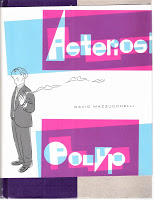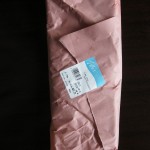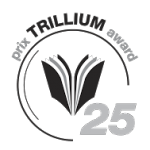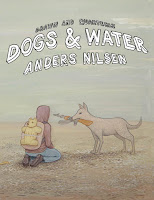 One of the most strange and memorable graphic novels I’ve read is Dogs and Water (M) by Anders Nilsen. The simple line drawings and spare text captivated me. There was as much white space on the page as narrative space,and I enjoyed having room to fill in my own details. So when I saw the large tome that is Nilsen’s most recent work, I borrowed it immediately. Somehow I’d managed to hear nothing about it, until suddenly it was in front of me, waiting to be read.
One of the most strange and memorable graphic novels I’ve read is Dogs and Water (M) by Anders Nilsen. The simple line drawings and spare text captivated me. There was as much white space on the page as narrative space,and I enjoyed having room to fill in my own details. So when I saw the large tome that is Nilsen’s most recent work, I borrowed it immediately. Somehow I’d managed to hear nothing about it, until suddenly it was in front of me, waiting to be read.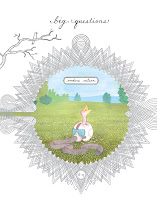 The front and back jacket flaps of Big Questions, or, Asomatognosia: whose hand is it anyway (M), list the main characters of the book, most of whom are finches. Each has a portrait and simple description. This beautiful enhancement is also quite functional – and reminiscent of Gabriel Garcia Marquez’s family tree at the beginning of One Hundred Years of Solitude (M). Big Questions is made up of many sections, and it’s hard to keep track of which finch is which, as they are distinguished mainly by their ways of interpreting the world, rather than by physical characteristics.
The front and back jacket flaps of Big Questions, or, Asomatognosia: whose hand is it anyway (M), list the main characters of the book, most of whom are finches. Each has a portrait and simple description. This beautiful enhancement is also quite functional – and reminiscent of Gabriel Garcia Marquez’s family tree at the beginning of One Hundred Years of Solitude (M). Big Questions is made up of many sections, and it’s hard to keep track of which finch is which, as they are distinguished mainly by their ways of interpreting the world, rather than by physical characteristics.The story goes something like this: a bomb falls, then a plane falls, and the people and birds are left to figure out what’s going on. If you feel a little jostled while reading this book, try to roll with it. In an interview with Publisher’s Weekly Comics World, Nilsen talks about creating narrative by finding connections between existing images. He draws first, and makes order after, unconcerned with linearity. As with Dogs and Water, there’s lots of room for interpretation. It’s rather similar to watching birds in real life.You notice some robins in the grass, digging in the dirt; or some starlings cleaning themselves in a puddle; you observe their colours, their flitting motions, you wonder what they’re thinking about, an d then suddenly they’re up and on their way elsewhere. And for me, watching the birds in this book give meaning to their experiences and perceptions made it easier to see the subjectivity of our own meaning-making.
So if you like to think about love and death and failure to perceive parts of one’s own body, i.e asomatognosia, check out this lovely, huge book written over many years. Or try one of these other graphic novels:
Source: http://www.thereader.ca/2012/06/staff-pick-big-questions-by-anders.html

